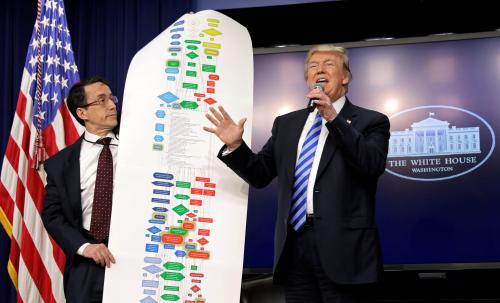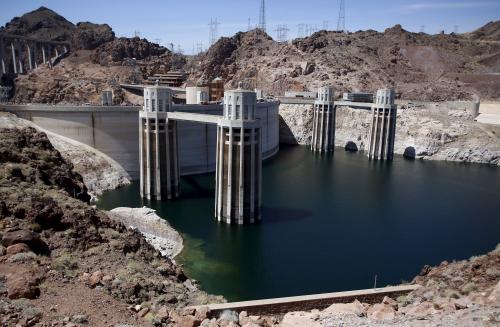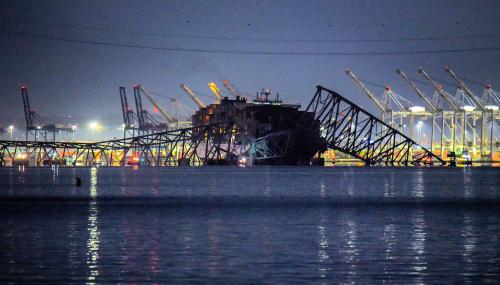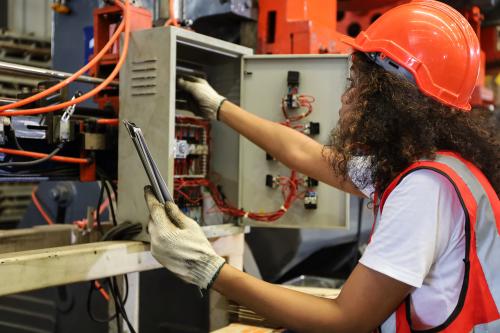A roundup of the 10 best infrastructure-related posts from the Brookings Metropolitan Policy Program
As Infrastructure Week 2017 kicks off, the Brookings Metropolitan Policy Program has put together a list of ten relevant and timely pieces it has produced over the last few years. This list should not only help plug you into the most pressing issues highlighted throughout the week’s events, but should also expand your field of vision to include all types of infrastructure and what they mean to the economy. After all, infrastructure stretches far beyond roads and bridges, connecting people to jobs, managing the flow of goods, and creating long-term pathways to economic opportunity.
Short- and long-term strategies to renew American infrastructure
By Adie Tomer and Joseph Kane
Investing in infrastructure has gained attention all across the country, but federal leaders are still developing their next generation strategy. That vision must articulate priorities and builds off the momentum of many actions already pioneered by cities and states. This paper begins to detail a broad array of short-term strategies and long-term policy reforms necessary to build and maintain a strong system of infrastructure that supports sustained and broad-based economic growth.
Beyond Shovel-Ready: The Extent and Impact of U.S. Infrastructure Jobs
By Joseph Kane and Robert Puentes
Any national infrastructure vision must recognize the widespread contributions that infrastructure jobs make to the nation’s economy. Since many of these jobs offer more equitable wages, require less formal education for entry, and are projected to grow over the next decade, they represent a key area of consideration for policymakers aiming to promote more economic opportunity.
Private Capital, Public Good: Drivers of Successful Infrastructure Public-Private Partnerships
By Patrick Sabol and Robert Puentes
Paying for infrastructure improvements remains a thorny question. This report provides a primer of public-private partnerships (PPPs), which continue to attract interest from leaders nationwide. It examines basic PPP structure, how to consider proper risk and reward sharing, and the purpose and the rationale behind these arrangements.
Banking on Infrastructure: Enhancing State Revolving Funds for Transportation
By Robert Puentes and Jennifer Thompson
Increasingly, state and local action has become crucial to support ongoing infrastructure investment. In particular, additional support can come in the form of below market revolving loans and loan guarantees from state infrastructure banks (SIBs), which this paper examines in greater depth.
Developing a common narrative on urban accessibility: Overview
By Adie Tomer and Jeff Gutman
While so much of the focus in federal Washington is how to pay for investment, what’s often lost in the shuffle is what all the infrastructure is intended to do. On the transportation side, it’s connecting people to opportunity, where local networks too often don’t offer easy “access” to jobs and other services. This blog highlights research undertaken as part of the Moving to Access (M2A) initiative, which aims to highlight the need for more equitable and sustainable development that ultimately helps people get where they need to go.
A New Alignment: Strengthening America’s Commitment to Passenger Rail
By Adie Tomer, Joseph Kane, and Robert Puentes
Passenger rail always sparks a lively debate in Washington, but more state capitals are initiating new investments and sparking local debates, too. This report is the first analysis to focus on metropolitan area statistics for passenger rail rather than individual stations or cities. Its findings help policymakers and state leaders better understand the location dynamics of Amtrak: where it works well, and the areas poised to benefit from new and expanded services.
Metro freight series: Global goods trade and metropolitan economies
By Adie Tomer, Joseph Kane, and Robert Puentes
Goods trade is a fundamental component of economic growth, but few understand it beyond delivery trucks crisscrossing our communities. The Metro Freight research series assesses goods trade at the metropolitan scale. It uses a unique and comprehensive database to capture all the goods moving in and out of U.S. metropolitan areas, both domestically and beyond. The reports in the series describe which goods move between metropolitan areas, how they move via different modes of transportation, and uncover the specific trading relationships between U.S. metropolitan areas as well as their global counterparts.
Global Gateways: International Aviation in Metropolitan America
By Adie Tomer
A crowd-favorite from 2012, this report provides first-of-its kind data on the flow of international passengers in and out of the largest U.S. metropolitan areas. It features data describing the scale of these flows and it calls out the international markets where these ties are particularly strong. What’s more, this tool goes beyond describing where passengers are going and tells us how they get there. Using data on transfer points and a map that visualizes each leg of each international route, it paints a portrait of how our global aviation infrastructure rises to meet the demand of international passengers.
Investing in water: Comparing utility finances and economic concerns across U.S. cities
By Joseph Kane
Infrastructure is not simply limited to transportation, but spans all types of facilities in need of improvement. This report examines the current context for local water infrastructure investment, with a particular focus on large drinking water utilities. As concerns continue to ripple from incidents in Flint, Mich. and beyond, cities remain at the forefront of many investment challenges, yet they often do not have a clear sense of where they stand relative to other markets.
Broadband adoption rates and gaps in U.S. metropolitan areas
By Adie Tomer and Joseph Kane
For many Americans, daily life orbits around a high-speed Internet connection. Workers and students go online to communicate and learn. Families stay in touch through live video feeds. Job seekers often need an electronic resume and an email address for applications. Smartphones put maps, social networks, and video streams in people’s pockets. The American economy has gone digital. With this in mind, this paper tracks current and changing broadband adoption rates at the metro level, with the results having clear implications for efforts to address the significant gaps in American Internet adoption.







Commentary
Every week should be Infrastructure Week
May 16, 2017